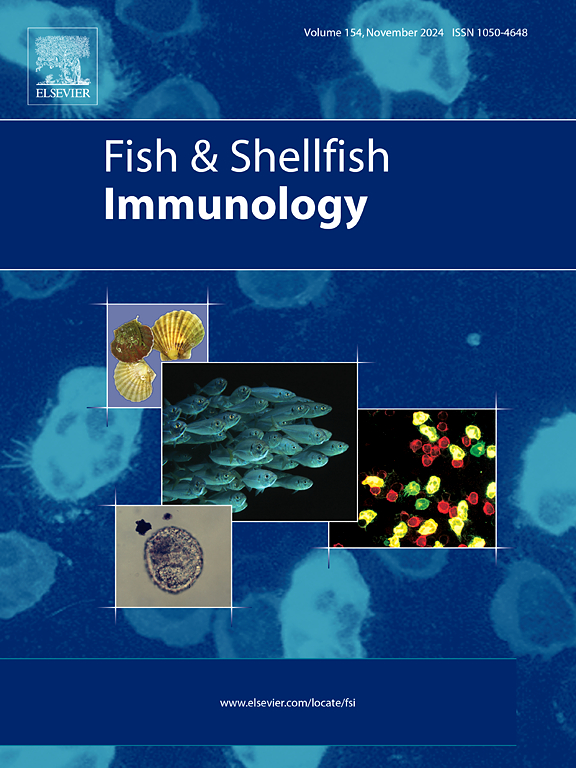富虾青素微藻粉对太平洋白对虾生长、健康和抗枯萎病的影响
IF 4.1
2区 农林科学
Q1 FISHERIES
引用次数: 0
摘要
在对虾养殖中,增强健康和抗病能力对可持续生产至关重要。本研究研究了富虾青素的雨生红球菌(HP)微藻粉对凡纳滨对虾(Litopenaeus vannamei)的生长效率、体组成、免疫和抗氧化反应、肠道健康、组织病理、基因表达和对茄枯病菌(Fusarium solani)抗性的影响。将初始体重为5.27±0.12 g的对虾分为4组,分别饲喂HP浓度为0、0.5、1和1.5 g/kg饲料(对照、HP 0.5、HP1和HP1.5)的饲料,饲喂8周。结果显示,hp饲喂组的生长、饲料利用率和存活率显著提高。这种改善是剂量依赖性的。添加HP后,蛋白质和灰分含量增加,脂肪含量降低。剂量依赖性增强抗氧化免疫反应在hp喂养组中是明显的。这可以通过高水平的超氧化物歧化酶(SOD)、过氧化氢酶(CAT)、谷胱甘肽过氧化物酶、血细胞总数、呼吸爆发、溶菌酶(LYZ)、酚氧化酶(PO)和吞噬活性以及proPO、LYZ、SOD和CAT基因的上调来证明。膳食中的HP影响了肠道细菌群落,减少了总需氧细菌和粪便细菌,增加了总益生菌和梭状芽胞杆菌数量。组织学调查显示,hp喂养组肝胰腺b细胞分泌囊泡增多,肌肉纤维变大。此外,饲料中添加HP显著降低了梭氏菌侵染后的死亡率,HP 0.5、HP1和HP1.5组的死亡率分别从对照组的65.00%降低到45.00%、35.00%和35.00%。根据折线回归模型,本研究推荐以1.2 g/kg日粮的最佳剂量饲喂HP。本研究为HP作为膳食补充剂改善凡纳米对虾的健康、生长和抗病能力提供了有价值的见解,标志着对虾养殖的重大进展。本文章由计算机程序翻译,如有差异,请以英文原文为准。
The benefits of astaxanthin-rich microalgal powder on growth, health, and disease resistance against Fusarium solani in Pacific white shrimp
In shrimp aquaculture, enhancing health and disease resistance is crucial for sustainable production. This study investigates the pioneering effects of astaxanthin-enriched microalgal powder from Haematococcus pluvialis (HP) on Pacific white shrimp (Litopenaeus vannamei), focusing on growth efficiency, body composition, immune and antioxidant responses, intestinal health, histopathology, gene expression, and resistance against Fusarium solani. Shrimp (initial weight 5.27 ± 0.12 g) were separated into four groups and fed diets supplemented with HP at concentrations of 0, 0.5, 1, and 1.5 g/kg feed (control, HP 0.5, HP1, and HP1.5), respectively, for 8 weeks. The outcomes revealed marked improvements in growth, feed utilization, and survival rate of the HP-fed groups. The improvement was dose-dependent. The protein and ash content increased and the lipid decreased with HP supplementation. A dose-dependent augmented antioxidant-immune response was obvious in the HP-fed groups. This is proven by the high level of superoxide dismutase (SOD), catalase (CAT), glutathione peroxidase, total hemocyte count, respiratory burst, lysozyme (LYZ), phenoloxidase (PO), and phagocytic activity with up-regulation of proPO, LYZ, SOD, and CAT genes. Dietary HP influenced the intestinal bacterial community, where it reduced total aerobic and fecal bacteria and rose total probiotic bacteria and Clostridium counts. Histological investigation showed increased secretory vesicles within B-cells in the hepato-pancreas and larger muscle fibers in the HP-fed groups. Additionally, dietary HP notably lowered mortality rates upon the F. solani challenge, with a reduction from 65.00 % in the control to 45.00 %, 35.00%, and 35.00 % in the HP 0.5, HP1, and HP1.5 groups, respectively. Our study recommends adopting dietary HP at the optimal dose of 1.2 g/kg diet relying on the broken line regression model. This study provides valuable insights into the potential of HP as a dietary supplement to improve the health, growth, and disease resistance of L. vannamei, marking a significant advancement in shrimp aquaculture.
求助全文
通过发布文献求助,成功后即可免费获取论文全文。
去求助
来源期刊

Fish & shellfish immunology
农林科学-海洋与淡水生物学
CiteScore
7.50
自引率
19.10%
发文量
750
审稿时长
68 days
期刊介绍:
Fish and Shellfish Immunology rapidly publishes high-quality, peer-refereed contributions in the expanding fields of fish and shellfish immunology. It presents studies on the basic mechanisms of both the specific and non-specific defense systems, the cells, tissues, and humoral factors involved, their dependence on environmental and intrinsic factors, response to pathogens, response to vaccination, and applied studies on the development of specific vaccines for use in the aquaculture industry.
 求助内容:
求助内容: 应助结果提醒方式:
应助结果提醒方式:


